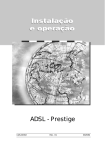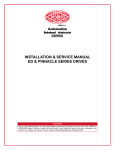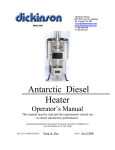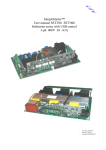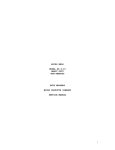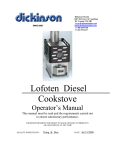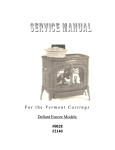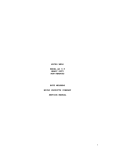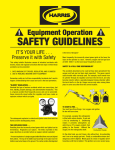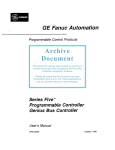Download MD Manual - Micro Products Company
Transcript
MICRO WELD MODEL MD 4, 5 & 6 FLASH BUTT WELDERS MICRO PRODUCTS COMPANY SERVICE MANUAL 1 TABLE OF CONTENTS 1.0 2.0 3.0 4.0 5.0 6.0 7.0 8.0 9.0 10.0 11.0 12.0 13.0 1.0 SPECIFICATIONS GENERAL OPERATING INSTRUCTIONS BASIC OPERATING PARTS BASIC OPERATING PARTS LOCATION TYPICAL OPERATING SEQUENCE SPECIAL ADJUSTMENTS PREVENTIVE MAINTENACE SUGGESTED SETTINGS DIAGNOISTIC CHART FOR TROULBE-SHOOTING ELECTRICAL SCHEMATIC SAFETY REMINDERS BUYERS GUIDE PARTS LIST SPECIFICATIONS Type of Welding Process Welding Range Material Suitability Standard Operating Voltages Maximum Line Demand 460 Volt Maximum Line Demand 230 Volt Single Phase AC Transformer Clamp Method Upset Method Mounting MODEL MD 4 Flash Weld .250 to .750 Steel Rod 460/230 Volts 115amps@100% duty cycle 362amps@10% duty cycle 230amps@100% duty cycle 724amps@10% duty cycle 75 KVA @ 50% duty cycle Pneumatic, Foot Controlled Motor, Adjustable 4-Caster Wheels MODEL MD5 Flash Weld .500 to 1.125 Steel Rod 460/230 Volts 137 amps@100% duty cycle 433 amps@10% duty cycle 274 amps@100% duty cycle 866 amps@10% duty cycle 90 KVA @ 50% duty cycle Pneumatic, Foot Controlled Motor, Adjustable 4-Caster Wheels Dimensions and Weights Height Overall Floor space Welding Die Height Weight 2.0 SPECIFICATIONS Type of Welding Process Welding Range Material Suitability Standard Operating Voltages Maximum Line Demand 460 Volt Maximum Line Demand 230 Volt Single Phase AC Transformer Clamp Method Upset Method Mounting 50 in. 50 in. 60 in. x 37 in. 43 in. 2025 LBS 60 in. x 37 in. 43 in. 2325 LBS MODEL MD 6 Flash Weld .750 to 1.500 Steel Rod 460/230 Volts 472amps@100% duty cycle 944amps@10% duty cycle 944amps@100% duty cycle 1888amps@10% duty cycle 308 KVA @ 50% duty cycle Pneumatic, Foot Controlled Motor, Adjustable 4-Caster Wheels Dimensions and Weights Height Overall Floor space 50 in. 40 in. x 85 in. Welding Die Height Weight 44 in. 5400 LBS 2 FEATURES • • • • • • • • Micro Weld quality and workmanship Heavy-duty construction & components East to operate controls Low maintenance costs Easy to set welding parameters Safety electrical switch circuits Heavy-duty weld heat selection switch Sensitive straight slide movable headpiece assembly 2.0 GENERAL OPERATING INSTRUCIONS 2.1 ELECTRICAL HOOK-UP INSTRUCTIONS First determine that available electrical service in your plant corresponds to the nameplate rating located on welder housing. Electrical wiring to welder must be of sufficient size to deliver full ampere load with no appreciable loss during weld cycle. The welder will not operate properly if there is more than a 10% variation in the line voltage. In general, the welder should be fused with a slow blow fuse of the 100% duty cycle rating. The minimum power cable size to the welder can be obtained by using this same current rating. Refer to National Electrical Code and local electrical regulations for adequate power sizes; disconnect methods and fusing guidelines. Remember line voltages to the welding machine are potentially dangerous should the power cords be damaged or severed. The welding voltages at the welding dies will not harm an operator since they do not exceed 10 volts. 2.2 SAFETY PRECAUTIONS (See section 11.0) 2.2.1 ELECTRICAL Maintain electrical cable to welder in good repair. Welder must be grounded and connections securely tightened. Heat Switch must not be changed to new position while a weld cycle is in process. Disconnect electrical service before serving welder – high voltages are located within the base of the welder. 3 2.2.2 MECHANICAL Operator while using welder must wear safety glasses. Keep all safety guards on welders and use properly. Operators must be instructed on basic operation of unit to prevent injury. Check nameplate rating and keep within material size range for each welder. 2.3 WATER-HOOK-UP (if so equipped) It is important that if a welder is to be operated for an extended period of time and heads heat up, water lines must be connected to the welder. Connect hoses to inlet and outlet provided at the back of the welder. Shut-off valve should be installed in the inlet line and the hose from the outlet should run to an open sight drain. Water should be turned off when welder is not in use. 2.4 AIR HOOK-UP Set air regulators for from 20 to 80 lbs. A safety pop-off valve will be activated when air gauge is set for over 100 lbs. 2.5 WELDING DIES The dies and shoes supplied with the welder will handle most size and material types within the range of the welder. For new weld applications consult the factory for special die and shoe sets. 4 3.0 BASIC OPERATING PARTS 3.1 WELD HEAT SELECTION SWITCH Weld heat is selected by means of a heavy-duty tap switch with 6 steps of voltage. The switch is conveniently located on the lower front of the welder. Number one indicates the high heat; number 6 indicates low welding heat. Other numbers are equally graduated from high to low to allow just the right amount of voltage for the weld operation. (Not illustrated) 3.2 HEAD OPEN SPACE STOP BOLT The head open space stop bolt is located on the top plate in the right rear. This adjustment is used to set the starting space between the dies. 3.3 HEAD CLOSED SPACE BOLT The head closed space bolt is located on the movable headpiece end plate. This adjustment is used to set the closed or finishing space between the weld dies. 3.4 WELD LIMIT SWITCH The weld limit switch is located behind a small door on the lower right of the front panel. 3.5 MOTOR LIMIT SWITCH The motor limit switch is located behind a small door on the lower right of the front panel. 3.6 WELDING DIES The welding dies (lower) and die shoes (upper), serve three purposes: 1. To carry current for welding 2. To align two ends of stock 3. To prevent material slippage during a weld cycle. Small rod is placed in the smaller grooves and the larger rod is placed in the bigger grooves. 5 3.7 WELDER PUSHBUTTON OPERATING STATION Four pushbutton switches make up the welder operating station. 3.7.1 WELD BUTTON This button activates all electrical circuits and initiates the weld flash cycle after all safety devices have been closed. 3.7.2 MOTOR BUTTON This button activates the motor drive circuits only and is used in adjusting welder spacing without activating the weld transformer. 3.7.3 ANNEAL BUTTON This button activates the manually operated anneal circuit only. 3.7.4 STOP BUTTON This button terminates all electrical cycles and can be used with the motor button to aid in making welder adjustments. 3.8 CLAMP ARMS The clamp arms are air operated. The foot controlled air valves are used to initiate the air clamp cylinders. The foot valves are located at the bottom of the welder housing. The right foot pedal operated the right clamp arm, and the left pedal operates the left clamp arm. To clamp stock, place it in the proper welding die groove and press the top edges of the tilt pedal on foot valve. To release stock, press on bottom edge of foot valve tilt pedal. CAUTION: Care must be used when clamping stock, be sure hands are clear of clamp arms. An air regulator with gauge is located on the left end of the welder and should be adjusted from 80-90 (PSI). Flow control valves are factory installed to keep clamp arm movement slowed. 3.9 MOTOR SPEED CONTROL The motor speed control is located on the right front panel. A potentiometer located on the control box will adjust the motor speed. A scale of 1-10 is found on the potentiometer, 1 is slow and 10 is fast. 6 4.0 BASIC OPERATING PARTS LOCATION 7 5.0 TYPICAL SEQUENCE OF OPERATION Wire to be joined must be free of rust, corrosion or other insulating materials, clean wire where it makes contact with welding dies. (Refer to section 8.0 for approximate settings.) 5.1 Adjust head open space. 5.2 Adjust head closed space. 5.3 Adjust weld limit switch. 5.4 Adjust motor speed. 5.5 Pinch cut stock ends. 5.6 Place stock into welding dies so wire ends meet midway between each welding die. Clamp into position with foot valve pedals. After clamping the stock into position there should be approximately 1/16” between stock ends. 5.7 Lower the flashguard to close the safety switch. 5.8 Press weld button firmly in and release. 5.9 Because of the amount of flashing it is advisable to step back from machine. 5.10 Welder will finish the weld cycle without assistance. 5.11 Unclamp stock leaving weld burr intact. 5.12 Hard drawn stock, mild or high carbon steel will require an anneal operation. (See 5.15) 5.13 Trim off weld burr so welded area is equal to parent material diameter. Incomplete burr removal or undercutting of the weld area will result in subsequent weld breaks. 5.14 ANNEAL OPERATION An anneal cycle may be incorporated to process material for improved bending qualities by placing welded stock into anneal dies located on welder. This may be a standard anneal device activated by a manual “Anneal Button” or an accessory device that will automatically process the anneal cycle, as explained below. 8 5.15 OPERATING INSTRUCTIONS – PULSATING ANNEAL TIMER UNIT To operate the pulsating anneal timer incorporated in the Model MD-4, MD-5 and MD-6 welder, remove the weld from the welding jaws and Reclamp the wire in the anneal jaws located in front of welder. The weld burr should be placed midway between the anneal jaws. Activate automatic anneal operating switch located on front panel. Before annealing a weld, it would be best to clamp a wire the same size as the wire to be welded in the anneal jaws as a test to determine the approximate timer settings. Set the anneal heat switch one heat higher than that used to weld the wire. Next, set top timer dial (total time) to around 30 seconds and the On-Timer to two seconds and the Off-Timer to two seconds. Depress and release anneal switch. Timers will complete the time cycle and turn off. If settings given above heat the wire too hot, any of these three settings may be lowered: (A) Anneal heat switch setting. (B) Overall time. (C) Time on. If setting does not heat the rod up enough, increase any one or more of the settings mentioned above. The Off-Time is used to allow heat pulses to spread out into the wire being heated. The ideal settings are those that cause the temperature to rise gradually to the correct anneal temperature and then cut off. Variations in the temperature from one time to another can be caused by not starting with approximately the same rod temperature or variations in electrical contact between the rod and anneal jaw. Once settings have been determined for a particular size and alloy, a chart can be made so they may be repeated. 9 6.0 SPECIAL ADJUSTMENTS 6.1 HEAT SWITCH SETTINGS This setting determines the amount of heat available for welding. In general use higher heat settings for larger stock and lower heat settings for smaller stock. Number one heat is the highest setting and number six heat is the lowest heat. 6.2 HEADPIECE CLOSED SPACE The closed space bolt should be adjusted to equal the diameter of the rod as measured between the dies at the groove being used to weld that particular stock size. The closed space should be set prior to setting the open space adjustment. Refer to Figure 4 for this setting. 6.3 HEADPIECE OPEN SPACE The headpiece open space is adjusted by a bolt that pushes against the lazy arm. (See Figure 5.) This setting must be made after setting the closed space adjustment. Use the method described in Figure 5 to establish the proper open space. 6.3.1 On the MD-6 Model, please refer to figures 1-5 in conjunction with Section 10, Print #B-5809. 10 6.4 WELD LIMIT SWITCH The weld limit switch adjustment will either increase or decrease the time of the heat cycle during the weld cycle. Determine which quadrant to change; a single winged nut maintains the quadrant position. Loosening this nut will enable the quadrant to be changed to a new position on a graduated scale etched on the quadrant. (Refer to Figures 1 & 2.) (Also refer to Section 8.0 for approximate setting.) 6.5 MOTOR LIMIT SETTING The motor limit switch quadrant is factory preset and should not need field adjustment. But if this ever needs adjustment—Determine which quadrant to change; a single winged nut maintains the quadrant position. Loosening this nut will enable the quadrant to be changed to a new position on a graduated scale etched on the quadrant. (Refer to Figure 1.) 6.6 DRIVE MOTOR ADJUSTMENT (DC Drive is Standard/AC Drive is Optional) This adjustment is made by turning a potentiometer on the front of the welder. A graduated scale of 1-10 is located on the potentiometer. #1 is slowest speed and is used for larger stock. During a weld cycle, there should be flashing when the ends of stock begin to touch and until the cam insert engages the lazy arm roller. If this does not happen, refer to Section 9.0. 11 12 13 7.0 PREVENTIVE MAINTENANCE TECHNIQUE MAINTENANCE PROCEDURES AS REQUIRED Keep in mind that these welders are precision built to last many years, but will require good maintenance procedures. They are designed to be as automatic as possible with a minimum dependence on the ability of the operator. Adjustments must be made by those thoroughly familiar with the operating principles of the welders. Brush loose flashings from dies, clamp shoes and flash tray to prevent excessive build-up. Check welding die shoes and dies for excessive wear. Replace both sets if they become excessively worn. Welding dies in poor condition is primary cause of poor welds. Welding die notes: Remove dies and clean or replace as necessary. By placing welding dies on fine emery cloth located on a flat surface, dies may be brightly polished. Brighten die seats on headpieces by placing emery cloth on a flat file. Replace dies and pull down tightly. 7.1 DAILY 7.1.1 Check for water leaks. 7.1.2 Check for air leaks. 7.1.3 Drain airline filter bowl. 7.1.4 Tighten any loose parts. 7.1.5 Clean flash pan. 7.2 WEEKLY 7.2.1 Repeat above service items 7.2.2 Grease following places with hand grease gun: A. Clamp arm pivot bearings. B. Headpiece slide bearings C. Upset lever arm bearing. 7.3 QUARTERLY-DISCONNECT POWER FROM WELDER 7.3.1 Repeat above service items. 7.3.2 Tighten transformer clamp retaining ring to prevent transformer laminations from vibrating out of place. 7.3.3 Blow all flashings from top of transformer to prevent shorting of secondary. 7.3.4 Check contacts on magnetic contactor, replace if worn badly burned. 7.3.5 Wash contacts on heat selection switch with carbon tetrachloride, dry with a clean cloth and place a thin coat of petroleum jelly on contacts. 14 7.4 ANNUALLY – DISCONNECT POWER FROM WELDER 7.4.1 Repeat above service items. 7.4.2 Check for wear in clamp arm bearings, replace when needed. 7.4.3 Check for excessive headpiece wear (die seats not lining up properly). 7.4.4 Check pop safety valve on air system to be sure they are operative. 7.4.5 Clean inside of welder housing. 7.5 WELDING DIES AND DIE SHOES INFORMATION Description: Welding dies – Lower conducting electrode and clamp jaw. Welding die shoes – Upper clamping member. Welding dies and die shoes in poor condition are the main causes of bad welds. CARE OF DIE SETS: 7.5.1 Use a brass or fiber blade to remove particles of flashings that build-up on die sets. Excessive flash build-up causes die burns on material and shorting of die sets. 7.5.2 Do not attempt to clamp material that is not suited for welder into die sets. Undersize materials will slip and burn die grooves, oversize materials will overstress clamping parts. 7.5.3 Do not use welding die sets for a vise. not withstand the mechanical abuse. These parts will 7.5.4 Whenever welding dies are replaced, clean bottoms of dies and corresponding die seats to a bright and clean condition before bolting them tightly into place. An oxidized surface will insulate the welding dies and reduce effective welding voltage. 7.5.5 Welding die shoes must swivel freely within clamp arm pivots to prevent cracking of die shoes. File down die shoe boss if necessary. 7.5.6 Welding die set will wear with use and must be changed occasionally for good welding results. Keep and adequate supply of replacement parts available. Wire and rod slippage is a problem caused by poor die sets and a major cause of wire breaks. 15 7.6 RECOMMENDED SHEAT CUTS FOR WELDERS 8.0 SUGGESTED SETTINGS MATERIAL SIZE MD-4 .250-.750 Steel ¼” Dia Steel 3/8” Dia Steel ½” Dia Steel 5/8” Dia Steel ¾” Dia MD-5 .500-1.125 Steel ½” Dia Steel ¾” Dia Steel 1” Dia Steel 1 1/8” Dia MD-6 .500-1.500 Steel 9/16” Dia Steel 5/8” Dia Steel ¾” Dia Steel 1” Dia Steel 1 1/8” Dia Steel 1 1/8” Dia Steel 1 ½” Dia STARTING SPACE BETWEEN DIES WELD HEAT FLASHING SPEED WELD LIMIT SWITCH SETTING 6 5 5 4 2 100% 90% 80% 70% 70% 1 1 1 4 4 6 5 2 1 100% 100% 60% 60% 1 ½ 2 2 ¾ 2 ¾ 1 3/8” 1 3/8” 1 ¾” 1 ¾” Front Front Rear Rear 100 PSI 100 PSI 100 PSI 100 PSSSI 6 6 6 4 4 4 2 100% 100% 90% 70% 65% 60% 50% 4 ¼ 4 ¼ 4 ¼ 3 3 2 1 2 1/8” 2 1/8” 2 1/8” 3” 3” 3” 3 ¼” Front Front Front Rear Rear Rear Rear 100 100 100 100 100 65 90 1 1 1 1 1 ½” ½” ½” ¾” ¾” GROOVE CLAMP PRESSURE Front Middle Middle Rear Rear 100 100 100 100 100 PSI PSI PSI PSI PSI PSI PSI PSI PSI PSI PSI PSI 16 9.0 DIAGNOSTIC CHART FOR TROUBLE-SHOOTING WELDING ACTION Starts flashing but cycle is broken and weld, if any, has large push-up or weld may pull apart. CAUSE Weld heat too low Upset speed too fast for welding heat Flashing cycle too long for stock size Does not start flashing, makes big burr or hot metal drops out before weld cycle is complete Weld cycle normal-yet voids found in weld Ends of stock too blunt Weld action normal until upset occurs then welder stalls Weld heat too low Weld limit switch set to hold on too long Lack of shims under upset cam Pinch cut on rod too tapered or flashing cycle is too short Too much shim thickness under upset cam Flashing cycle too short Weld burns on stock Dirty stock causing poor contact between die and material Weld limit switch set to hold on too long Too much heat stored in rod during flashing Flashing speed too slow or weld heat too hot Dirty stock Variations in welding Dirty dies Loose upset cam Flashing and weld cycle seem normal but weld is pulled apart while hot Input voltage variations Misalignment of rods Loose welding die or transformer secondary connection Worn die grooves Starting gap between dies too great Loose headpiece slide shafts Ends or rod bent REMEDY Increase weld heat Slow down flash cycle Allow small space between ends of stock when placed in welding dies Grind or cut stock to chisel point Increase weld heat or slow down upset speed Increase weld heat or slow down upset speed Add extra shims under upset cam (1/32” at a time) Change angle of rod cut or adjust for longer flash cycle Remove some of upset cam shims Decrease flashing speed or increase weld heat Clean scale or rust from stock Readjust limit switch to cut out sooner Space ends apart to shorten flash cycle Increase flashing speed Remove rod scale before welding Wire brush die grooves Tighten cam-check locking key Check input voltage only 5% drop permissible Clean and tighten secondary connections Replace dies Reduce starting space either with motor limit switch or space adjusting screw Return to factory for recementing Straighten 6” of material where rod meets dies 17 9.1 ELECTRICAL TROUBLE-SHOOTING OF WELDER (Caution!! Extreme care should be exercised when making these tests. Dangerous voltages are present in the welder. Only persons familiar with electrical safety precautions should perform these tests.) 9.1.1 TROUBLE-SHOOTING TABLE (See section 9.1.3) This electrical trouble-shooting table is furnished as a suggested method of trouble-shooting the welder. The individual steps of the table should be performed in the order given, to make the tests valid. The electrical schematic (section 10) furnished for these tests show the table test points. The table may be used for welders with a different but closely related wiring by using corresponding test points. During all tests, line voltage should be connected to L1 & L2 of the welder. The heat switch should be set to the #1 position. 9.1.2 FINAL ELECTRICAL CHECKS Set the heat switch to the number 1 position, connect the voltmeter across the welding dies. Press the operating switch. The meter reading will typically be less than 10 VAC. Consult the weld specification sheet for this value. Rotate the heat switch through all settings. If the voltage is not read at any setting, the heat switch may be defective. Actuate the weld limit switch; observe the reading goes to zero. Release the weld limit and operating switches, the reading should remain at zero. 18 9.1.3 TEST LEAD CONNECTION X1 X2 X2 FU1-1 X2 FU1-2 X2 LS3-2 X2 PB1-2 X2 LS1-2 X2 Ls1-2 X2 PB3-2 X2 LS2—1 X2 X2 X2 X2 L2 L2 L2 LS2-2 CRW-2 PB4-1 PB4-2 CRW-3 CRW-4 T1-1 METER READING 115 115 115 115 115 115 115 115 115 VAC VAC VAC VAC VAC VAC VAC VAC VAC 115 VAC 115 VAC 115 VAC 115 VAC Line voltage Line voltage Line voltage PROBLEM IF NO READING Bad control transformer Bad fuse connection Open fuse Open flashguard switch Open stop switch LS1 open CRM contacts open Bad weld switch Open connection to weld limit switch Open weld limit switch PB4 or CRW defective Open wire to anneal switch Bad anneal switch Open wiring to contactor Bad contactor Open wire to heat switch PRESS OPERATING SWITCH WELD LIMIT SWITCH ACTUATED PRESS ANNEAL SWITCH X X X X X X NOTE: To perform repair consult section 13 for parts identification. 19 10.0 ELECTRICAL SCHEMATIC 20 21 22 23 24 25 11.0 SAFETY REMINDERS The following accident prevention information is presented to eliminate potential hazards while operating, inspecting or repairing Micro-Weld electric resistance welding equipment. Important safety compliance information for Micro-Weld Welders. GENERAL 1. Qualified personnel, prior to using equipment, must instruct an operator on basic operation and malfunction methods. 2. Safety eyeglasses must be worn by all personnel operating or servicing welders. 3. Use safety equipment properly and keep safety equipment on welders. 4. Determine that both operating voltages and hertz (cycles) of power supply correspond to ratings listed on welder nameplate located on welder housing. 5. Check nameplate ratings and keep within capacities and material categories stated therein. 6. Adjustments or repairs must be made by persons thoroughly familiar with operating principles of welder. 7. Welder must be disconnected from power supply prior to maintenance or repair procedures. ELECTRICAL 1. Refer to National Electrical Code and local regulations for adequate electrical wiring to power welder. Do not operate welder with inadequate electrical power supply cords or cable. 2. All welders must be grounded through power supply and welder ground connection terminal securely tightened. 3. All welders must be able to be disconnected from power source either by a double breaking disconnect switch or unplugged by standard rated plugs. 4. All welders must be fused to prevent injury should an electrical malfunction occur. Welders must never be fused for an ampere load that exceeds the ratings stated on welder nameplate. Normally welders are fused using the nameplate rated load; time lag parameters functional to standard fuses allow this specification. 5. Electric power cords to welder must be kept in good condition. Report any damage or potential hazards to maintenance personnel. 6. The weld heat selection switch, potentiometer or range selection devices must not be changed to a new position while a weld operation is in process. 26 12.0 BUYERS GUIDE HOW TO ORDER PARTS: You must provide 1. Machine Model 2. Machine Serial Number 3. Voltage Then identify part(s) on part list (last page in book) and provide MICRO with the circled number. CALL MICRO at 800-872-1068 OR FAX MICRO at 630-787-9360 Provide MICRO with your company name and purchase order number. 27 13.0 PARTS LIST 28 29 PARTS LIST MD 4 & 5 WELDERS MODEL/ PART NO MD-01A MD-01B MD-04 MD-04A MD-05 MD-08L MD-08R MD-08AL MD-08AR MD-09 MD-10 MD-11 MD-12 MD-12A MD-12B MD-12C MD-13 MD-13A MD-14 MD-20 MD-21 MD-22 MD-23 MD-25 MD-26 MD-27 MD-30 MD-31 MD-32 MD-33 MD-35 MD-36 MD-37 MD-38 MD-39 MD-40 MD-41 MD-43 MD-44 MD-45 MD-46 MD-47 MD-47H MD-48 MD-48H MD-49 DESCRIPTION Basic head assembly Complete head assembly, no dies, no shoes Shaft wipes, felt Shaft wipe retaining ring Head return spring Clamp arm, left Clamp arm, right Clamp arm for arm anneal, left Clamp arm for arm anneal, right Arm pivot pin, steel Arm pin washer Grease zerk 90 degrees Clamp cylinder #50 Cylinder replacement diaphragm Cylinder shaft boot Clamp cylinder clevis Foot pedal, clamp Hand operated clamp valve Pedal mount screw End plate stationary head End plate mount bolt End plate movable head End plate mount bolt, movable head Closed head space adjusting screw End plate insulation Muffler Stationary anneal extension bar Front anneal bar Anneal bar mount bolts Movable anneal extension bar CA anneal clamp, each (front) CAL anneal, pair Anneal clamp mount bolt Arm anneal die set (4 pieces) Anneal die mount screw Complete truck Truck door Swivel caster Stationary caster, special order #4 shear Shear mount bolt Standard vise Heavy duty vise Standard vise bracket Heavy duty vise bracket Vise bracket mount bolt ITEM NO. 30654 30661 30640 48219 80059 30554 30614 30643 30644 30526 30517 48422 77706 77713 77718 77727 77859 77864 90611 30548 90687 40551 90203 30523 30641 77892 62079 62080 90260 62081 62155 62020 90260 30524 90617 40571 40540 48108 48117 64009 90295 78112 78111 60022 60005 90295 30 PARTS LIST MD 4 & 5 WELDERS MODEL/ PART NO MD-50 MD-51 MD-52 MD-53 MD-54 MD-55 MD-56 MF-57 MD-58R2 MD-58V2C MD-58V2A MD-60R MD-60S MD-60SL MD-60SR MD-62S MD-62SA MD-62SL MD-62SR MD-62SS MD-63S MD-64 MD-65 MD-70F MD-70FP MD-70FS MD-70S MD-71U MD-71L MD-72 MD-78 TS-06 MD-82 MD-83A MD-83C MD-87 MD-88 MMD-89 MD-120B MD-121B MD-121C MD-122B MD-123B MD-124B MD-125B DESCRIPTION Vise mount bolt Flashguard assembly Flashguard mount bolt Flash shield safety switch Upset cover Upset cover mount screw Flash tray Flash tray mount bolt Contour dies, pair, 3 grooves Standard dies, copper Standard dies, alloy Contour shoes, pair Shoes complete w/inserts insulation, pair Shoe, left Shoe, right Set of inserts (4 pieces) Insert screw Left insert Right insert Straight insert Insulation for shoes (set) Shoe attaching bolt Die attaching bolt Complete transformer Primary Secondary Shunt Transformer ring, upper Transformer ring, lower Transformer studs Control step down transformer 6 point heat switch Heat switch mount bolt Contactor, state voltage & Serial number Contactor repair kit, state voltage & serial number Terminal block 3 stage anneal timer Anneal timer operating switch Upset cam with insert Insert only, for cam Insert shim Insert attaching screw Upset leverage bar w/roller Roller Roller axle ITEM NO. 90262 30656 30672 57813 30551 90656 40500 90202 30662 30594 30618 30673 30660 30542 30543 30659 90703 30536 30537 30535 30671 90664 90657 50558 50569 50515 50527 50506 50535 50521 59525 56549 90294 57611 APPL 53000 50572 57810 30667 30529 30530 90619 30530 30521 30520 31 PARTS LIST MD 4 & 5 WELDERS MODEL/ PART NO MD-126B MD-127B MD-128B MD-129 MD-129A MD-130B MD-131B MD-132B MD-133B MD-134B MD-135B MD-136B MD-137B MD-138 DESCRIPTION Pivot bushing, leverage bar Pivot bushing bolt Open stop bolt Quadrant mount plate Quadrant plate spacers Weld switch quadrant Motor switch quadrant Quadrant mount bolt Quadrant switch lever Lever mount bolt Cutoff cam switch Cutoff cam set screw Cutoff cam spacer Limit & motor cutoff switch ITEM NO. 30522 90687 90040 50529 40608 50508 50510 90021 30525 90262 30532 90015 30534 57813 MD-157 MD-158 MD-159 Thyrite resistor 4 button operating station Flow control valve 58132 57854 778/62 MD-500 MD-501 DC motor control Gear reducer w/motor n.s. 57734 40616 32 PARTS LIST MD 6 WELDER MODEL/ PART NO MD-01B MD-01A MD-04 MD-07 MD-07A MD-08 MD-08A MD-09 MD-10 MD-10A MD-10B MD-10C MD-16MD2 MD-16MD3 MD-MD60S MD-19 MD-19A MD-20 MD-20A MD-20B MD-20C MD-20D MD-08B MD-21 MD-22 MD-23 MD-24 MD-24A MD-24B MD-24C MD-26 MD-27 MD-27A MD-27B MD-28 MD-29 MD-30 MD-31 MD-32 MD-36 MD-36A MD-37 MD-38 MD-38A MD-38B MD-39C DESCRIPTION Basic head assembly, with shafts & shields Stationary head attaching bolts Head return spring Clamp arm pivot pin Bell crank pivot pin Left clamp arm Right clamp arm Clamp eccentric leveling block Bell crank Bell crank block pin Bell crank block Bell crank retaining screw Standard copper dies 2 V groove Standard copper dies 3 V groove Die shoes, standard Shoe attaching screw washer Attaching screw insulating washer Shoe attaching screw Shoe screw insulating tube Shoe boss insulating washer Shoe boss insulating ring Shoe insulating plate Arm insulating spacer Die attaching screw Movable head end plate End plate insulation Secondary shunt Shunt clamp plates Shunt attaching screws, long (14) Shunt attaching screws, short (4) Open space adjustment screw Upset pressure plate Upset plate mount screw Upset plate insulation (optional) End plate mount screws Anneal mount bracket Weld transformer Primary coil Transformer secondary Clamp cylinder stud Cylinder stud nuts Clamp link stop block Clamp cylinder Clamp cylinder clevis Clamp cylinder boot Clamp cylinder clevis ITEM NO. 30067 90683 80059 30014 30015 30080 30081 70005 70007 70010 70004 90665 30060 30059 30065 30068 30068 90691 30069 30070 30071 30072 30073 90689 30074 30075 50004 50000 90330 90329 30000 30076 90661 30077 90660 30058 50005 50016 50017 70001 92066 70002 77707 77714 77719 70009 33 PARTS LIST MD 6 WELDER MODEL/ PART NO MD-120 MD-120A MD-121 MD-122 MD-123 MD-124 MD-125 MD-126 MD-127 MD-48 MD-49 MD-129 MD-129A MD-130A MD-130B MD-131 MD-133 MD-134 MD-135 MD-136 MD-137 MD-138 MD-139 MD-140 MD-141 MD-142 MD-25 MD-25A MD-25B DESCRIPTION Upset cam only Upset cam complete Upset cam insert Upset cam shim Upset lever bar Lever bar rollers Axle for roller Lever bar pivot bushing Lever bar pivot bolt Upset cover Head return assist spring Quadrant plate Quadrant plate spacer Weld switch quadrant (limit) Motor switch quadrant Quadrant mount bolt Quadrant switch lever Switch lever mount bolt Switch operating cam Cam set screw Cam spacer Limit & motor switch Motor 3 H.P. Speed reducer Motor sprocket Speed reducer sprocket 3/8” ship for closed stop 5/16” shim for closed stop ¼” shim for closed stop D.C. motor control 4 push button control station Thyrite resistor 8 point heat switch 300 amp Speed reducer Motor pulley Speed reducer pulley Chain Belt ITEM NO. 30083 30085 30084 30086 30087 30521 30510 30522 90687 40618 80045 30679 40608 50508 50510 90217 30525 90262 30532 90015 30534 57813 57743 57746 APPL APPL 30676 30678 30678 57736 57854 57676 57857 57746 APPL APPL APPL APPL 34





































